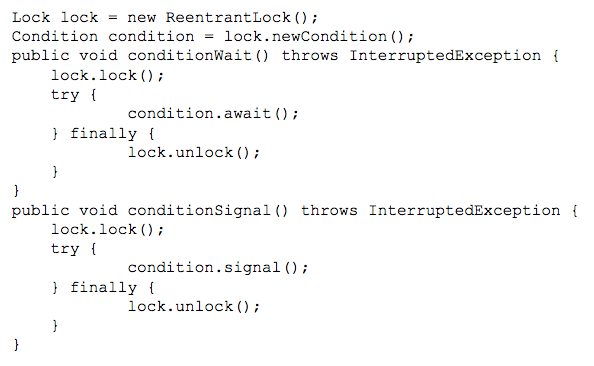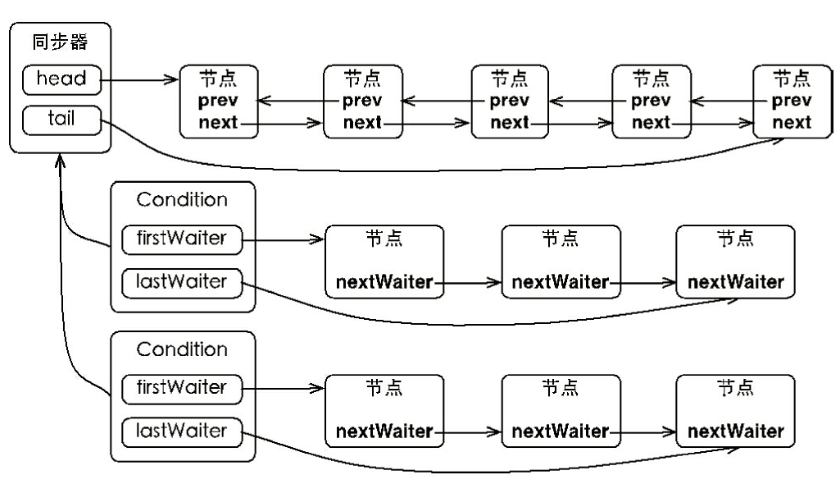简介
Condition中的await()方法相当于Object的wait()方法,Condition中的signal()方法相当于Object的notify()方法,Condition中的signalAll()相当于Object的notifyAll()方法。
不同的是,Object中的wait(),notify(),notifyAll()方法是和"同步锁"(synchronized关键字)捆绑使用的;而Condition是需要与"互斥锁"/"共享锁"捆绑使用的。
简单应用:

Condition的实现分析
Condition是同步器AbstractQueuedSynchronized的内部类,因为Condition的操作需要获取相关的锁,所以作为同步器的内部类比较合理。每个Condition对象都包含着一个队列(等待队列),该队列是Condition对象实现等待/通知功能的关键。
等待队列:
等待队列是一个FIFO的队列,队列的每一个节点都包含了一个线程引用,该线程就是在Condition对象上等待的线程,如果一个线程调用了await()方法,该线程就会释放锁、构造成节点进入等待队列并进入等待状态。

这里的节点定义也就是AbstractQueuedSynchronizer.Node的定义。
一个Condition包含一个等待队列,Condition拥有首节点(firstWaiter)和尾节点(lastWaiter)。当前线程调用Condition.await()方法时,将会以当前线程构造节点,并将节点从尾部加入等待队列。
在Object的监视器模型上,一个对象拥有一个同步队列和等待队列,而Lock(同步器)拥有一个同步队列和多个等待队列。

等待(await):
调用Condition的await()方法,会使当前线程进入等待队列并释放锁,同时线程状态变为等待状态。
从队列的角度来看,相当于同步队列的首节点(获取了锁的节点)移动到Condition的等待队列中。
当等待队列中的节点被唤醒,则唤醒节点的线程开始尝试获取同步状态。如果不是通过Condition.signal()方法唤醒,而是对等待线程进行中断,则抛出InterruptedException。
public final void await() throws InterruptedException {
if (Thread.interrupted())
throw new InterruptedException();
// 添加至等待队列中
Node node = addConditionWaiter();
// 释放同步状态,释放锁
long savedState = fullyRelease(node);
int interruptMode = 0;
while (!isOnSyncQueue(node)) {
LockSupport.park(this);
if ((interruptMode = checkInterruptWhileWaiting(node)) != 0)
break;
}
if (acquireQueued(node, savedState) && interruptMode != THROW_IE)
interruptMode = REINTERRUPT;
if (node.nextWaiter != null) // clean up if cancelled
unlinkCancelledWaiters();
if (interruptMode != 0)
reportInterruptAfterWait(interruptMode);
}
通知(signal):
调用Condition的signal()方法,将会唤醒在等待队列中从首节点开始搜索未解除Condition的节点,在唤醒节点之前,会将节点移到同步队列中。
Condition的signalAll()方法,相当于对等待队列中的每个节点均执行一次signal()方法,将等待队列中的节点全部移动到同步队列中,并唤醒每个节点的线程。
public final void signal() {
if (!isHeldExclusively())
throw new IllegalMonitorStateException();
Node first = firstWaiter;
if (first != null)
doSignal(first);
}
public final void signalAll() {
if (!isHeldExclusively())
throw new IllegalMonitorStateException();
Node first = firstWaiter;
if (first != null)
doSignalAll(first);
}
栗子
经典问题,消费者/生产者:
package ConsumerAndProduce;
import java.util.concurrent.locks.Condition;
import java.util.concurrent.locks.Lock;
import java.util.concurrent.locks.ReentrantLock;
/**
* Created by zhengbinMac on 2017/2/20.
*/
class Depot {
private int capacity;
private int size;
private Lock lock;
private Condition consumerCond;
private Condition produceCond;
public Depot(int capacity) {
this.capacity = capacity;
this.size = 0;
this.lock = new ReentrantLock();
this.consumerCond = lock.newCondition();
this.produceCond = lock.newCondition();
}
public void produce(int val) {
lock.lock();
try {
int left = val;
while (left > 0) {
while (size >= capacity) {
produceCond.await();
}
int produce = (left+size) > capacity ? (capacity-size) : left;
size += produce;
left -= produce;
System.out.println(Thread.currentThread().getName() + ", ProduceVal=" + val + ", produce=" + produce + ", size=" + size);
consumerCond.signalAll();
}
} catch (InterruptedException e) {
e.printStackTrace();
} finally {
lock.unlock();
}
}
public void consumer(int val) {
lock.lock();
try {
int left = val;
while (left > 0) {
while (size <= 0) {
consumerCond.await();
}
int consumer = (size <= left) ? size : left;
size -= consumer;
left -= consumer;
System.out.println(Thread.currentThread().getName() + ", ConsumerVal=" + val + ", consumer=" + consumer + ", size=" + size);
produceCond.signalAll();
}
} catch (InterruptedException e) {
e.printStackTrace();
} finally {
lock.unlock();
}
}
}
class Consumer {
private Depot depot;
public Consumer(Depot depot) {
this.depot = depot;
}
public void consumerThing(final int amount) {
new Thread(new Runnable() {
public void run() {
depot.consumer(amount);
}
}).start();
}
}
class Produce {
private Depot depot;
public Produce(Depot depot) {
this.depot = depot;
}
public void produceThing(final int amount) {
new Thread(new Runnable() {
public void run() {
depot.produce(amount);
}
}).start();
}
}
public class Entrepot {
public static void main(String[] args) {
// 仓库
Depot depot = new Depot(100);
// 消费者
Consumer consumer = new Consumer(depot);
// 生产者
Produce produce = new Produce(depot);
produce.produceThing(5);
consumer.consumerThing(5);
produce.produceThing(2);
consumer.consumerThing(5);
produce.produceThing(3);
}
}
某次输出:
Thread-0, ProduceVal=5, produce=5, size=5 Thread-1, ConsumerVal=5, consumer=5, size=0 Thread-2, ProduceVal=2, produce=2, size=2 Thread-3, ConsumerVal=5, consumer=2, size=0 Thread-4, ProduceVal=3, produce=3, size=3 Thread-3, ConsumerVal=5, consumer=3, size=0
输出结果中,Thread-3出现两次,就是因为要消费5个产品,但仓库中只有2个产品,所以先将库存的2个产品全部消费,然后这个线程进入等待队列,等待生产,随后生产出了3个产品,生产者生产后又执行signalAll方法将等待队列中所有的线程都唤醒,Thread-3继续消费还需要的3个产品。
参考资料:
《Java并发编程的艺术》 - 5.6 Condition接口
